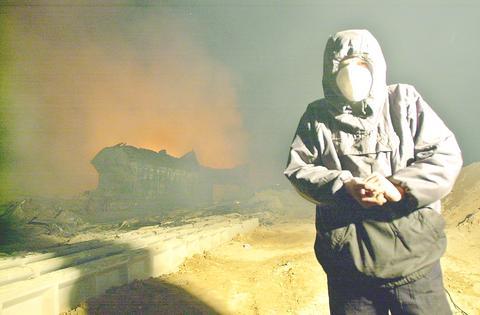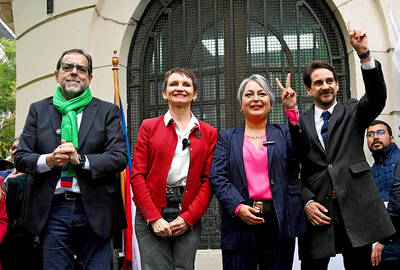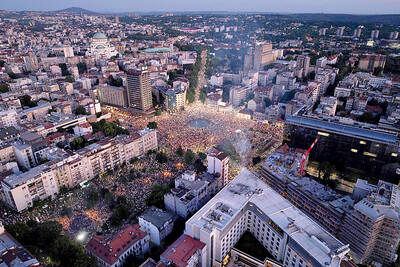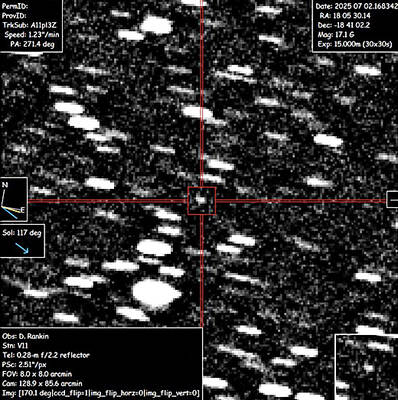Fireman yesterday extinguished the last blazes on a runaway freight train loaded with fuel and chemicals that blew up in eastern Iran and killed over 300 people, allowing rescue workers to start digging for more victims.
Revolutionary guards cordoned off a wide area around the disaster site overnight due to fears of further blasts and pollution, leaving relief teams helpless to search the rubble of shattered mud houses for more bodies.
But at dawn the head of the Khorasan province emergency headquarters, Vahid Barakchi, said: "There have not been any further explosions since last night and the danger of further explosions has disappeared."

PHOTO: AP
"Firefighters have given the all-clear. There is no danger and rescue teams need only wear ordinary masks," he said.
Authorities decreed a day of mourning in Iran's northeastern province as the dead -- many of them firemen, security forces and local officials -- were to be buried in the nearest town, Nishapur.
Speaking by mobile phone from a crater ripped open by Wednesday's massive blast, Barakchi said the death toll stood at 309 with some 460 people injured, and more corpses might be found beneath the ruins of a village.
Many of the bodies were charred beyond recognition.
Engineers began lifting the mangled wreckage of 51 train cars that broke loose and hurtled downhill until the train derailed from the main Tehran-Mashad rail line and caught fire.
Roads and Transport Minister Ahmad Khorram said that the cause of the disaster had not yet been determined. Repairs were expected to take three days.
Some initial reports said the cars were detached by earth tremors, but officials said the explosion, which sent shock waves felt some 70km away in the city of Mashad, was so massive that it may have been confused with an earthquake.
Barakchi said the lethal cocktail of gasoline and fertilizer had polluted the nearest village, Deh-e No Hashemabad. Three other villages were devastated by the blast.
The train cars had first caught fire and attracted crowds of bystanders who were then engulfed along with firefighters in a massive explosion.
Doctors called for supplies of blood to treat the hundreds of people who were injured, many of them scorched black by Wednesday's fiery chemical blast.
The force of the explosion razed homes to the ground, crushing their inhabitants under crumbled mud brick walls and shattering windows far around.
"The earth shook. We thought it was an earthquake. We were so scared," said Ali, 42, from Nishapur, 20km from the scene in the saffron-growing province of Khorasan.
Photographs showed the blast site strewn with shredded torsos, clothes ripped from bodies and severed limbs.
Ali Soleimani said he found the body of the governor of Nishapur: "I pulled out the corpse of the governor myself. He had no legs and was sliced to bits."
The disaster came amid political uncertainty in Iran, ahead of parliamentary elections today overshadowed by a bitter dispute over the mass disqualification of reformist candidates.
The country is still recovering from a December earthquake that killed over 40,000 people in the ancient city of Bam.
In the worst rail crash of the last quarter century, at least 575 people died in June 1989 when two passenger trains in Russia's Ural mountains were engulfed in an explosion from a leaking gas pipeline.

Two former Chilean ministers are among four candidates competing this weekend for the presidential nomination of the left ahead of November elections dominated by rising levels of violent crime. More than 15 million voters are eligible to choose today between former minister of labor Jeannette Jara, former minister of the interior Carolina Toha and two members of parliament, Gonzalo Winter and Jaime Mulet, to represent the left against a resurgent right. The primary is open to members of the parties within Chilean President Gabriel Boric’s ruling left-wing coalition and other voters who are not affiliated with specific parties. A recent poll by the

TENSIONS HIGH: For more than half a year, students have organized protests around the country, while the Serbian presaident said they are part of a foreign plot About 140,000 protesters rallied in Belgrade, the largest turnout over the past few months, as student-led demonstrations mount pressure on the populist government to call early elections. The rally was one of the largest in more than half a year student-led actions, which began in November last year after the roof of a train station collapsed in the northern city of Novi Sad, killing 16 people — a tragedy widely blamed on entrenched corruption. On Saturday, a sea of protesters filled Belgrade’s largest square and poured into several surrounding streets. The independent protest monitor Archive of Public Gatherings estimated the

Irish-language rap group Kneecap on Saturday gave an impassioned performance for tens of thousands of fans at the Glastonbury Festival despite criticism by British politicians and a terror charge for one of the trio. Liam Og O hAnnaidh, who performs under the stage name Mo Chara, has been charged under the UK’s Terrorism Act with supporting a proscribed organization for allegedly waving a Hezbollah flag at a concert in London in November last year. The rapper, who was charged under the anglicized version of his name, Liam O’Hanna, is on unconditional bail before a further court hearing in August. “Glastonbury,

FLYBY: The object, appears to be traveling more than 60 kilometers per second, meaning it is not bound by the sun’s orbit, astronomers studying 3I/Atlas said Astronomers on Wednesday confirmed the discovery of an interstellar object racing through the solar system — only the third-ever spotted, although scientists suspect many more might slip past unnoticed. The visitor from the stars, designated 3I/Atlas, is likely the largest yet detected, and has been classified as a comet, or cosmic snowball. “It looks kind of fuzzy,” said Peter Veres, an astronomer with the International Astronomical Union’s Minor Planet Center, which was responsible for the official confirmation. “It seems that there is some gas around it, and I think one or two telescopes reported a very short tail.” Originally known as A11pl3Z before